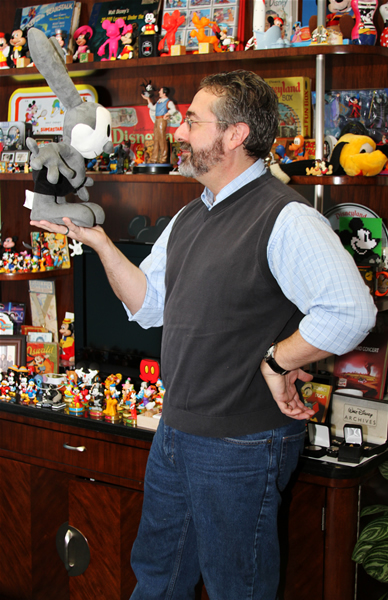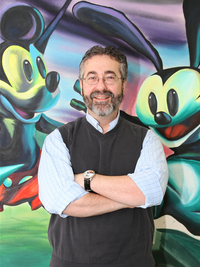Until late last year, game designer Warren Spector was best known as the man behind the cyberpunk classics System Shock and Deus Ex. Then, in time for the 2010 holiday season, Spector seemed to be everywhere, promoting a title that seemed completely out of character: Disney Epic Mickey, which premiered exclusively on the family-friendly Wii. (At this writing, Disney has not announced a Japanese debut.)
The story behind this radical genre-switch goes back to 2007, when Spector sold his Austin-based Junction Point studio to The Walt Disney Company, making it a member of Disney Interactive Studios. “I’ve been a huge Disney geek most of my life and always wanted to work for the Mouse,” Spector wrote back then on his blog. “I love creating original stuff but, man, the idea of having access to Disney’s history―and future―is hugely compelling.”
Disney Epic Mickey is steeped in that history. The game takes place in Wasteland, a parallel Disney universe filled with “retired” characters and theme park attractions that reflect hours of Disney archival research. A starring role is reserved for Oswald the Lucky Rabbit, who returned to the Disney fold almost 80 years after Walt Disney lost him to a distributor in 1928. When I first saw a preview of the game at Junction Point in May 2010, I was transported back to my Southern California childhood. In its look and feel, Wasteland captures the day-glow feeling of the early Disneyland “dark rides,” as well as the color palette of the studio’s early Technicolor classics.
- A game designer’
s role isn’ t well understood. What exactly do you do all day? I do whatever my team needs to succeed: everything from writing a design document to going out and getting pizza. It’s not that I’m the greatest software developer in the world, or the most creative design genius. I think I have a good knack for identifying really talented people and then making them better.
- What’
s your working style? I’m a demanding guy. There’s almost nothing in the world I hate more than settling for something that isn’t is as good, as cool, as fun or as innovative as it could be. Making games is very hard: it takes a lot of people, time and money. Usually that money is coming from somewhere other than the team. So a lot of teams have no choice but to knuckle under to financial pressures. I’ve done a pretty good job of not doing that.
- Your core philosophy is “playstyle matters.” I’
ve heard you’ ve posted that phrase in every room of your studio. You’ll see it in 2-inch tall lettering over here, 12-inch lettering over there: it’s everywhere. I’ve done that as a reminder to the team that being clever and creative are nowhere near as important to the success of the player experience, as how creative we allow our players to be. If anything accounts for my success over the past 20-plus years, it’s because I won’t deviate from that. A game that’s just about puzzles or shooting everything that moves isn’t worth doing. If it’s not about empowering players to tell their own stories, I have no interest.
- Where in your career did that evolve?What were you reacting to?
It goes all the way back to my earliest Dungeons and Dragons experience. I’ve been a movie fan all my life. I love reading. I love linear narrative media. But in the late 70s, I fell in with a group of writers and comic book creators who were playing Dungeons and Dragons. This crazy game wasn’t about us listening to someone else’s story, but about creating our own story, together. The power of that idea was so immense that I wanted to do that for a living. And when I got into the video game business a decade later, I noticed that a lot of the games were essentially a designer telling players what exactly they must do to complete the game, and in what sequence. My aim was to counter that by bringing the role-playing experience of Dungeons and Dragons to video games―to allow players to tell their own story.
- How has your team applied that to Disney Epic Mickey?
In Disney Epic Mickey, every step you take, every minute you are playing the game, you have the joy of deciding: are you going to erase that thing in front of you or instead use paint to change its behavior. You can paint in a wall because that will make this other character like you better. Or you can erase it because that’s the most efficient way to accomplish your goal. You also have a fair amount of control over what quests you pick. You get to decide how you interact with the other characters in the world, who you help, who you don’t. In turn, the game tracks all these choices, and at the end of the game, we add them up so that your end game reflects exactly what you did. At all of those levels, the game is about you, not about me or the design team.
Mickey is my twentieth full-scale game. Every one of them has been about expressing the idea that playstyle matters. I’ve seen just how incredibly creative players can be. A year after we shipped Deus Ex, I watched someone playing a part of the game that I had seen played a thousand times before. And he tried something I had never seen anyone try before. And sure enough, that tactic worked. That’s a creative act, and it’s really powerful stuff.
- You’
ve talked about the influence of American comics on you growing up. What about manga and anime? Manga has never captured my imagination. I don’t know if it’s a cultural thing or an art style thing. But I have certainly found anime I adore. Ghost Michelle is amazing. With anime, there’s an over-the-top emotionalism that I find really appealing. Maybe it’s because I don’t know how to exceed it. I love the kinds of games I make, but I wish I could take the emotional content up a notch. That’s one of the things we were trying to do with Mickey―I wanted the players to have an emotional reaction. I’ve gotten more heartfelt fan mail about this game than any other I’ve ever worked on. There are people who are being truly touched by what is happening in the game, and that’s pretty cool.
- For me, the look and feel of Disney Epic Mickey captures what I remember coming from Disney when Walt Disney was alive. How did you instill that in a young team of developers who didn’
t have that first-hand experience? It took a lot of brow beating. I didn’t start Junction Point as a Disney studio. When Disney asked if I was interested in doing this, I had to sell my team on the idea of making a Mickey Mouse game. Most of them had signed on to do stuff like Deus Ex and Thief―adult-oriented dark, serious games. Mickey Mouse has a whole different set of requirements, and I knew going in that I had to be faithful to what has kept Disney and Mickey relevant for 80 plus years. Right out the chute, I had a series of what I called “Come to Mickey” meetings. I said “this is what we’re doing guys, and if you don’t want to do this, let’s part ways and stay friends.” Most of the team remained, and I told them they would to have to become Disney experts. I had them watch every Mickey Mouse and Oswald cartoon that exists, and most of the Disney classics. We watched them, talked about them, went to the archives and did a lot of research. I have lots and lots of books about Disney history and art, and we pored over those.
Early on it was a struggle. This is a Nintendo game, so there was the temptation to take elements from Mario and Zelda--bright, shiny, happy video game colors and environments. I said “no” a lot. I kept saying: “Show me the real Disney inspiration. Don’t make stuff up; go find a Disney reference for everything we do.”
- That inspiration seems to include the actual experience of some Disneyland attractions, many of which were--and are--darker in tone than people realize. You might visit the park by day. But some of the most memorable experiences seem to be set at night.
Absolutely―we were able to get into the park before they opened and study the rides. We got video of every ride. We really did go back to the source. I’m happy to say that well before the end of the project, a team of people who hadn’t known all that much about Disney became fans. They really did become Disney experts, and that comes through in the game. Throughout the game I used to say: “that’s not Disney-ish enough.” I remember the first time we got the end game cinematic composited: edited together and with all the audio, sound, music and visual effects. I was bawling like a baby, because the emotion came through in exactly the way I hoped it would. We did Disney, and I was so proud. We wanted to do justice to Walt and his vision, and I think we did that.
- You are from New York, but Junction Point is in Austin, Texas. Why there?
Richard Florida, who has written books about the “creative class” in the United States, points out that centers of creativity aren’t typically in major metropolises anymore. Creative centers have thriving technology, educational, and music scenes. Austin has all of those. It’s the state capital. It has technology manufacturing―hardware, software, you name it. It has the University of Texas. It has the most amazing live music scene in the world. It has more bookstores per capita than anywhere but San Francisco. It attracts young people because, as the slogan says, we want to “Keep Austin Weird.” The Austin game community started back in the 1970s with guys like Steve Jackson and Richard Garriott, who respectively founded a tabletop game company and a computer game company here. They set the seeds for the amazing game development community that has since grown up. And it’s still cheap to live. If you’re young and out to change the world, and want to work with three friends in a garage to do it, that probably won’t happen in a place where it costs $5,000 a month to rent an 800 square-foot condo.
- How many miles have you put on since you finished the game?It seems like, for a while, you were giving interviews on Disney Epic Mickey from all over the world.
<Laughing> It’s was like two or three trips to Europe ― 6,000 to 7,000 miles each way. Plus I don’t know how many trips to New York and California―another 2,000 each. So probably 50,000 to 60,000 miles.
- What about Asia?
I’ve never, ever been to Japan or China or Hong Kong, and it drives me nuts. I want to go there so badly.




